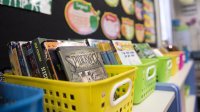A Simple Way to Encourage Students to Read More Broadly
When students experiment with ways of classifying books beyond reading levels, they may feel liberated from strict ideas about what they should be reading.
Your content has been saved!
Go to My Saved Content.Librarians and classroom teachers use various systems of classification to organize collections, from the Dewey Decimal System to interest or reading levels. But what if we were to organize books in a way that deemphasized reading levels and encouraged students to read more broadly?
When educators use the term vertical alignment, we are often referring to a progression of skills or content that increases in complexity. With respect to reading, rather than using achievement or assessment benchmarking levels, which is often discouraged in the librarian world, school librarians use designations that most closely align to education groupings and the comfort or reading-experience level of the reader. Labels like PB (picture book), CB (chapter book), MG (middle grade), YA (young adult), or AD (adult) are often placed on spine labels and in library catalogs to make it easier to identify titles that readers will enjoy, but the readers themselves rarely notice them.
In classroom and school libraries, many people, including me, have begun the process of genrefication, or organizing fiction titles in library collections by genre, rather than the problematic, difficult to independently navigate Dewey Decimal System. After genrefying my library collection, I noticed increased circulation and interest from classroom teachers in developing independent-reading units to allow for greater autonomy and engagement in language arts instruction.
All Books Belong to All Readers
One of the projects we planned and executed together had the goal of supporting students’ liberation from strict ideas about what books they should be reading. Often, without realizing it, when we lean too heavily on data pertaining to reading levels and achievement and share this information with students, it can lead to the development of prejudicial ideas about which books belong to which grades and readers. In my library, I much prefer the message that all books belong to all readers.
I presented the idea about vertically aligned stacks to my colleague Alexander Maughan, and we collaborated to create some virtual stacks in Sora, a reading app for students, as examples. We first created them as lists, then read the titles aloud and challenged students to create their own stacks around the writing unit about motifs that they were studying.
Mr. Maughan and I each built stacks with one title from each level. We chose “picture books” all the way up through “adult” titles that we felt were strong examples of motifs. From there, students built their own stacks and shared them with one another. We integrated an analytical writing task into the unit that was designed to connect all the titles together with an explanation of the motifs from each of the titles. One stack, for example, had Kwame Alexander’s The Undefeated, Torrey Maldonado’s What Lane?, David Barclay Moore’s The Stars Beneath Our Feet, and Ta-Nehisi Coates’s Between the World and Me.
Though it may be challenging for younger students to build stacks with adult titles, the project can be modified to have students include more titles from fewer reader-designation groups. For example, elementary students might focus on building stacks that consist completely of board, picture, and chapter books. In this way, the lines between levels become blurred, which can be a good thing. Removing the stigma attached to reading levels complements genrefication work, providing greater access for those historically disadvantaged by leveling systems, with respect to both assessment and reading engagement.
New Discoveries, Greater Equity
One of the most exciting parts about using vertically aligned stacks to increase reading engagement is that students inspire one another with books they might not typically discover when limited to reading titles they believe match their skill level. We know that there are any number of issues with standardized testing and assessments used to determine reading proficiency. Those of us who purport to view education as a means for empowerment and liberation from oppressive structures must rethink the way the tools we use can and often are weaponized, causing prolonged harm to those relying on us for help.
When students share vertically aligned stacks with one another, this has the added benefit of supporting students in becoming curators of content, forming connections independently. They can then build library collections, create displays, even conduct whole-community reading initiatives. Every once in a while, I meet parents who read longer books to babies, and not too long ago, I had the pleasure of checking out Jesmyn Ward’s The Fire This Time (Lexile 1230) to a sixth grader. The possibilities are endless when we remove barriers and think more expansively about what it truly means to develop a lifelong love of reading.
